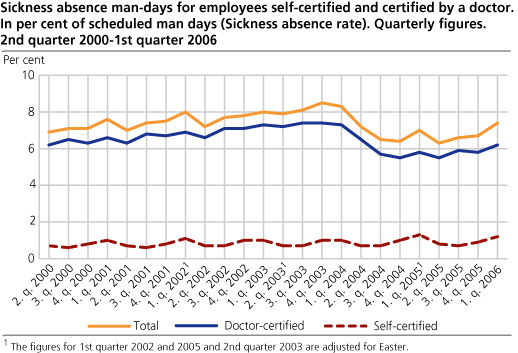Content
Published:
This is an archived release.
Continued increase in the sickness absence
The sickness absence increased from 7.1 per cent in the first quarter of 2005 to 7.4 per cent in the first quarter of 2006. Absence certified by a doctor increased from 5.8 to 6.2 per cent, and the self-certified absence decreased from 1.3 to 1.2 per cent.
The rise of sickness absence from 7.1 to 7.4 per cent, corresponds to an increase of 4.3 per cent. For men the increase was 2.3 per cent and for females 6.2 per cent. The sickness absence was 2.5 per cent lower than it was in the first quarter of 2001, the year when the agreement on an inclusive labour market was implemented.
Increase in most larger industries
Among the larger industries, the growth in sickness absence was largest in health and social work where the increase was 7.8 per cent. The growth of sickness absence was also relatively strong in education with an increase of 6.1 per cent.
The sickness absence decreased by 0.2 per cent in Real estate, business activities, while in construction and in manufacturing and mining the increase was well below average with increases of 1.0 and 2.7 per cent, respectively.
Increase in almost all counties
The sickness absence decreased by 0,1 per cent in Aust-Agder, and the increase was well below average in Sogn og Fjordane with an increase of 1.1 per cent and in Oslo with an increase of 1.8 per cent. The growth was largest in Hedmark with 12.2 per cent and in Finnmark with 10.9 per cent.
The sickness absence level was still highest in Finnmark with 10.9 per cent and lowest in Rogaland with 6.0 per cent.
Increase in the proportion of long-lasting absences
Sickness absence lasting more than 31 days within the quarter, added up to 58.2 per cent of the sickness absence in the first quarter of 2006. This was an increase from 56.2 per cent in the first quarter of 2005.
Strongest increase in Local government
In local government, the sickness absence increased by 7.6 per cent from the first quarter of 2005 to the first quarter of 2006. The sickness absence increased by 5.8 per cent in Central Government including the state hospitals. Within this sector, the sickness absence increased by 7.5 per cent in health care and by 5.0 per cent in public administration. The sickness absence increased by 2.9 per cent in private sector and public enterprises.
The following results are based on data on sickness absence certified by a doctor, as the survey on self-certified absence does not contain data on sickness absence by age.
Rise in age groups between 30 and 60 years old
The sickness absence increased in all age groups, with the exception of males aged 20-24 years. The strongest increase is found among females between 40 and 60 years old where the sickness absence increased by more than 10 per cent.
The sickness absence rate measures the proportion of scheduled man-days lost due to own sickness. The statistics do not cover self-employed persons.
The sickness absence statistics are produced in cooperation with the National Insurance Administration (RTV).
Tables:
- Table 1 Sickness absence man-days for employees self-certified and certified by a doctor. In per cent of scheduled man-days (Sickness absence rate). Quarterly figures. 2000-2006
- Table 2 Sickness absence man-days for employees self-certified and certified by a doctor, by sex. In per cent of scheduled man-days (Sickness absence rate). Quarterly figures. 2000-2006
- Table 3 Sickness absence man-days for employees self-certified and certified by a doctor, by industry and type of sickness absence. In per cent of scheduled man days (Sickness absence rate). Quarterly figures. 2000-2006
Contact
-
Arbeidsmarked og lønn
E-mail: arbeidsmarked@ssb.no
-
Unn H. Høydahl
E-mail: unnh.hoydahl@ssb.no
tel.: (+47) 40 90 23 77

